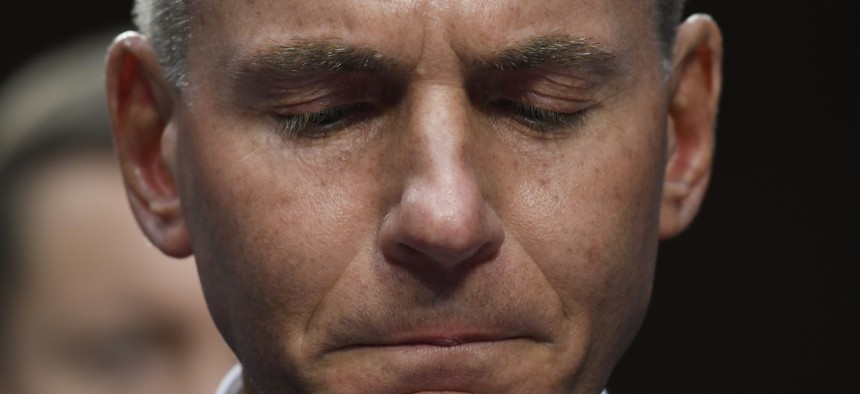
Dennis Muilenburg speaks to the families sitting in the audience on Capitol Hill in Washington, Tuesday, Oct. 29> AP Photo/Susan Walsh
Boeing Has Relieved CEO Muilenburg. Now What?
The next CEO will have to right the 737 program, keep the tanker on track, and figure out why a recent rocket launch went awry.
Boeing dismissed its embattled CEO on Monday as the company begins the process of repairing its reputation and reshaping a culture that Dennis Muilenberg has spent his career molding.
Boeing CFO Greg Smith will serve as acting CEO until Jan. 13, when David Calhoun, who replaced Muilenberg as chairman in October, will step into the job. Calhoun will be replaced as chairman by Larry Kellner, a former Continental Airlines CEO who sits on Boeing’s board.
Muilenburg spent his entire career with Boeing, beginning as an intern in the 1980s and working his way to the 36th floor of the company’s headquarters in Chicago. He was appointed CEO in 2015, and two years later found himself in the Twitter crosshairs of a new president incensed about the projected $4 billion cost of planned Air Force One jets. Muilenberg turned on the charm. He smoothed things over with Trump, an aviation enthusiast who owns his own Boeing 757 and Sikorsky helicopters. The Boeing CEO personally negotiated the Air Force One contract, even meeting with Trump in the Oval Office and at his Mar-a-Lago resort in Palm Beach.
The Iowa native was thrust further into the national spotlight following two deadly crashes of the company’s popular 737 Max jetliner. The October 2018 and March 2019 crashes claimed a total of 346 lives. But in the aftermath, Muilenburg sounded more like a broken record, excessively relying on talking points. On the company’s most recent earnings call, he used the phase “safe return to service” of the 737 Max (or a variation of that phase) 13 times. Moreover, the frequent critique was that he, and other engineers at the company, lacked empathy.
“In our mind, the Boeing CEO has our key stakeholder groups to please,” Citi analyst Jon Raviv wrote in a note to investors on Monday after the company announced Muilenburg’s firing. “By frustrating (at least) or angering (at most) most of those stakeholders during the MAX crisis, it’s hard for any [Boeing] CEO to maintain the position.”
The 737 Max is at the top of the list of problems within Boeing Commercial Airplanes. It’s still unclear whether U.S. and international regulators will approve the company’s proposed fixes to the computer system that is believed to have caused both crashes. The delays are costing Boeing billions and the airlines hundreds of millions of dollars. Some airlines have canceled scheduled 737 Max flights through the spring. Earlier this month, Boeing said it would temporarily stop building Max aircraft, leaving thousands of its supplier employees wondering if they would be furloughed or laid off.
Beyond that, the company has faced delays while developing a new version of its long-range 777. Boeing this year was also expected to announced plans to build a new jetliner to replace its dated 757, but fell down the ladder as fixing the Max has become the company's top priority.
The next CEO, Calhoun, will also take over two relatively stable businesses, Defense, Space & Security and Global Services, the latter a division that focuses on maintenance and repair of commercial and military aircraft and equipment.
But all has not been rosy there either. Repeated problems have delayed the U.S. Air Force KC-46 aerial refueling tanker, a plane that Boeing has built for nearly four decades. The Air Force’s top acquisition official charged that Boeing has assembly line culture problem after it was discovered that workers left tool and trash inside of tanker the company delivered to the military.
Still, Boeing’s defense business has captured billions of dollars in new orders, notably to build training jets and helicopters for the Air Force and refueling drones for the Navy.
Last week, its NASA space capsule, which is supposed to bring astronauts into orbit, was unable to dock with the International Space Station. The Starliner capsule, which did not have any astronauts onboard, safely landed in New Mexico this week.
Boeing’s race to keep pace with European rival Airbus contributed to the Max being raced into service. Now, it could take a decade or more for it to catch up again airlines look to Airbus for new jets while Boeing remains idle.
NEXT STORY: Best of 2019: The Business of Defense
